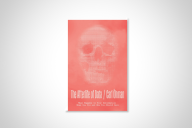You have /5 articles left.
Sign up for a free account or log in.
Philosophers have lives; saints have legends. No miracles are associated with Simone Weil (1909-43), and a glance at reference books on philosophy finds her listed alongside Jean-Paul Sartre and Simone de Beauvoir, her classmates at the École normale supérieure. But she looks odd in their company -- in any company, really. Frail but indomitable, she was in the world but not quite of it.
French intellectuals of her generation wrote essays on Marxism and the Spanish Civil War, while she worked in a factory and went to the front as part of an antifascist militia. She had an extraordinarily acute (some would say morbid) awareness of the depths and the extent of human suffering; it made comfort seem like complicity. Combine that sensitivity with her conviction that our world is the diminished or faulty image of a realm in which truth and justice are real and absolute – a Platonic notion, flecked perhaps with Gnostic elements -- and you have someone with a vocation, rather than a career.
Weil died at the age of 34, under what seem to have been suspiciously beatific circumstances: she succumbed to tuberculosis after months of refusing to eat more than the rations available to the French compatriots under German occupation. Her collected writings, which run to several stout volumes, range from pacifist essays and interventions in trade-union debates to reflections on atheism and mysticism (not entirely antithetical terms, in her experience) and studies of classical Greek literature and philosophy. Most of this work remained unpublished during her lifetime, apart from scattered essays in journals of no wide circulation.
At a couple of points in Julia Haslett’s film “An Encounter with Simone Weil,” the camera focuses on a few lines of a manuscript, the words in French and Greek. Her handwriting appears small, precise, and highly concentrated – like Weil herself, by all accounts. “She was apparently unacquainted with doubt,” wrote Raymond Aron, a philosopher and political journalist who knew her in the 1920s, “and, although her opinions might change, they were always thoroughly categorical.” His choice of words may allude to one of Weil’s nicknames from their student days: “The Categorical Imperative in Skirts.”
“An Encounter with Simone Weil,” billed on its Facebook promotional page as “a documentary by Julia Haslett,” made the rounds of film festivals in 2011, and in the meantime the director (a visiting associate professor of cinema and comparative literature at the University of Iowa) has screened it at two dozen colleges and universities throughout the United States. It will be available on DVD and various digital platforms sometime in the next few months. Upon request, the director sent me a screener, indicating that she had just finished work on the French language version. The film is already available in Italian, with the German and Japanese translations due out this fall, and a Korean version in the works.
“Encounter” is at least as much a personal essay as a biographical portrait. Haslett’s fascination began when she came across a quotation from one of Weil’s letters: “Attention is the rarest and purest form of generosity.” It was an ideal point of entry, given how often Weil’s aphorisms sound like one of Pascal’s Pensées, and also how much moral and intellectual significance the word “attention” turns out to have in her work.
But it also carried a strong personal connotation. In the voiceover Haslett tells us of her father’s suicide when she was young, and in a video clip her brother discusses his struggle with anxiety and depression. “My father's death taught me that if I don't pay attention, someone might die," she says -- an enormous burden to have to carry.
Although Weil cannot be said to lighten the load, she at least understood the stakes. “The capacity to give one's attention to a sufferer is a very rare and difficult thing,” she says in another passage that Haslett quotes. “It is almost a miracle; it is a miracle.”
In short order she read Francine Du Plessix Gray’s biography of Weil (published by Penguin in 2001) in a single sitting. "Here was this brilliant, deeply ethical young woman speaking truth to power, putting her body on the line for her convictions, and providing such an incisive critique of political and economic power,” she told me an in e-mail exchange. “And yet I'd never read her. That despite studying philosophy, religion, and history at Swarthmore College -- an institution that embodies the Weil-like values of rigorous intellectual inquiry and a deeply held commitment to social justice.”
In recounting Weil’s period as a left-wing militant in the early years of the Great Depression, “Encounter” shows Haslett going over film footage of mass demonstrations in the archives of the French Communist Party – searching, almost desperately, to catch a glimpse of Weil in the crowd, but with no luck. She visits the apartment building in New York where Weil lived for a few months in 1942, and interviews the (very) few remaining people who knew Weil, as well as one of the editors preparing her collected works.
The effort to establish a connection with the philosopher even extends to having Soraya Broukhim (an actress with some resemblance to Weil) read enough of Weil's work to improvise responses in a mock interview. The sequence is odd. By the end, the situation has become unmistakably awkward for both parties. When Broukhim complains that Haslett seems to want answers she can’t give, the effect is strangely revealing. For a moment, it’s not quite clear whether she’s doing so in character, as Weil, or in real life.
To call Haslett’s quest a kind of pilgrimage would be tempting, if not for the most striking thing about the film: its emphasis on her as a secular figure and an activist. Most people who become interested in Weil do so through the theological side of her work. Even her appeal for nonbelievers, such as Albert Camus, comes in large measure from an awareness of her "tortured prowling outside the doors of the Catholic Church, like a starving wild animal,” to borrow the poet Kenneth Rexroth’s apt characterization.
Weil’s spiritual writings “are certainly the reason she gets studied in this country,” Haslett acknowledged by e-mail. “For example, many of the annual meetings of the American Weil Society are held at theological seminaries and most participants are religious scholars or at least people of faith.” But for the director, “it was the way she combined such an incisive critique of power and her willingness to sacrifice everything to tell the truth as she knew it (by directly experiencing that about which she wrote) that drew me in so completely.… She became a guide for me through the very dark first decade of this century, when our politicians were dispensing with the truth and our media wasn't holding them accountable.”
The film gives due attention to Weil's religious passion, but suggests that her mystical turn came after deep disillusionment with radical politics. Haslett seems largely uninterested in the very difficult matter of Weil’s relationship to Judaism. (Her parents were so completely assimilated into French secular culture that they neglected to mention this element of her identity until she was about 10 years old). And the director treads lightly around the topic of Weil’s mental health, although she does briefly consider the possibility that the final period of self-denial may have been a kind of suicide by self-starvation.
Haslett makes her resistance to certain aspects of her subject’s life and thought explicit, saying in one voiceover that she felt “betrayed by Weil’s turn toward God.” This does not detract from the value of the film in the least.
On the contrary, ambivalence and discomfort are essential to any meaningful encounter with Weil. To borrow a remark by T.S. Eliot, whose grounds for admiration were as different from Haslett’s as they could be: “I cannot conceive of anybody agreeing with all of her views, or of not disagreeing violently with some of them. But agreement and rejection are secondary: what matters is to make contact with a great soul.”
For more information about the film, or to arrange a screening, see the Line Street Productions website.








